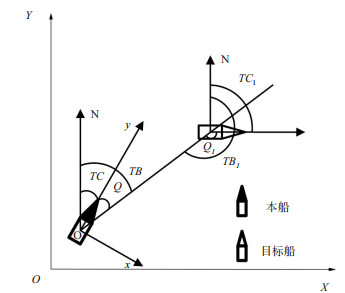A Method of Risk Identification and Decision-making Support for Ship Maneuvers at Chengshanjiao Waters Under Traffic Separation Scheme
-
摘要: 针对成山角分道通航制水域船舶航行风险高的问题,对数字化仿真环境、风险辨识、避碰机理和操纵决策开展研究。通过解构成山角水域的构成要素,建立静态交通环境的数学模型,结合船舶动态信息,构成动静结合的数字化仿真环境;基于时间、空间双维度的碰撞危险度模型和本船船位信息,提出碰撞等航行风险的辨识方法;考虑《1972年国际海上避碰规则》和良好船艺要求,归纳成山角水域不同会遇局面下的避让原则和方法,结合避碰机理求取最小改向幅度;运用时序滚动和反馈补偿方法,提出能自适应目标船机动特征的操纵决策模型。模拟成山角水域船舶会遇场景,开展多目标船场景下的仿真实验,结果表明:①在自建坐标系的会遇场景中(目标船:坐标位置(44 600 m,62 300 m),航向210°,航速12 n mile/h;本船:坐标位置(41 200 m,38 000 m),航向000°,航速12 n mile/h),基于成山角水域船舶行为的船位推算方法可提前1 168 s识别到碰撞危险;②在随机生成的多目标船模拟环境下,本船在245,617,2 005,2 405 s分别采取右转17°、复航、右转11°、复航操作,可让清所有目标船,满足船舶在该水域航行时操纵决策的需求。综上,提出的方法在成山角水域可更早识别到碰撞危险并进行操纵决策,为船舶在类似分道通航制水域中智能航行的实现提供理论基础。Abstract: Simulation of environment, risk identification, collision avoidance and decision-making support for ship maneuvers are studied in order to counteract the high risk associated with shipping at Chengshanjiao waters under traffic separation scheme(TSS). The shipping environment of the Chengshanjiao waters is analyzed and digitalized to develop a static nautical environment model, and the dynamic traffic is investigated to set up a digitalized shipping simulation system. A method for risk identification is proposed based on the positions of ships and a collision risk model considering both space and time dimension. Good Seamanship and International Regulations for Preventing Collisions at Sea(COLREGS)are used to summarize the principles of ship maneuvers in different scenarios, and a ship maneuver meeting the principle of"minimum course altering"is produced based on the collision avoidance mechanism. A decision-making model adaptive to the random motions of target ships is developed using a rolling-window method and a feedback compensation method. Shipping traffic at the Chenshanjiao waters is simulated and multiple-ship scenarios are introduced. Study results show that: ①The proposed risk identification method using dead reckoning can identify the risk 1 168 s earlier than the regular methods at the Chengshanjiao waters when the own ship locating at(41 200 m, 38 000 m)heading to 000°with a speed of 12 n mile/h encounters with the target ship at(44 600 m, 62 300 m)heading to 210° with a speed of 12 n mile/h. ②Under a simulated multiple-ship scenario, the own ship can avoid collisions with target ships by altering to the starboard 17° at 245 s, resuming to sail at 617 s, altering to the starboard 11° at 2005 s, and resuming to sail at 2 405 s, which meets the principle of Good Seamanship. In conclusion, the proposed method can identify the collision risk earlier and support decision-making on ship maneuvers better than other methods at the Chenshanjiao waters, which provides a theoretical foundation for developing intelligent navigation systems on waters under TSS.
-
表 1 各航段主交通流方向与Oz表示的航段
Table 1. Main traffic flow direction of each segment and the segment represented by Oz
航段编号 航段区域 交通流方向/(°) 航段编号 航段区域 交通流方向/(°) O1 ${O_{P3_1^3}}$ 150 O9 ${O_{P1_3^3}}$ 120 O2 ${O_{P3_2^3}}$ 180 O10 ${O_{P1_3^1}}$ 300 O3 ${O_{P3_1^1}}$ 330 O11 ${O_{P1_2^1}}$ 300 O4 ${O_{P3_2^1}}$ 0 O12 ${O_{P1_2^3}}$ 120 O5 ${O_{P1_1^3}}/{O_{P2_1^3}}$ 120 O13 ${O_{P1_2^1}}/{O_{P2_2^1}}$ 300 O6 ${O_{P2_4^3}}$ 180 O14 ${O_{P2_3^1}}$ 0 O7 ${O_{P1_1^1}}/{O_{P2_1^1}}$ 300 O15 ${O_{P1_2^3}}/{O_{P2_2^3}}$ 120 O8 ${O_{P2_4^1}}$ 0 O16 ${O_{P1_1^3}}$ 180 表 2 会遇局面辨识模型
Table 2. Identification model of ship encounter
船舶分类 会遇局面 条件 第1类:存在潜在碰撞危险且u > 0 对遇 Q∈[0°,5.7°]∪[354.3°,360°],Q1∈[0°,5.7°]∪[354.3°,360°] 或Q∈(0°,112.5°)∪Q1∈(0°,112.5°) 或Q∈(247.5°,360°)∪Q1∈(247.5°,360°) 追越 让路船 Q∈(0°,90°]∪[270°,360°),Q1∈(112.5°,247.5°) 直航船 Q∈(112.5°,247.5°),Q1∈(0°,90°]∪[270°,360°) 交叉 让路船 Q∈(0°,112.5°) 且不是追越或对遇局面 直航船 Q∈(247.5°,360°) 且不是追越或对遇局面 第2类:不存在潜在碰撞危险或u = 0 表 3 对比实验船舶参数
Table 3. Ship's Parameters of comparative experiment
船类 坐标/m 航速/(n mile/h) 航向/(°) 本船 (41 200,38 000) 12 0 目标船 (44 600,62 300) 12 210 表 4 对比实验结果
Table 4. Results of comparative experiment
碰撞危险识别方法 辨识到碰撞危险的时间/s 避让行动/(°) 复航时间/s 基于航速矢量 1 625 右转17 2 246 基于船舶行为 457 右转7 1 670 表 5 2船实验参数
Table 5. Parameters of a two-ship experiment
局面 船类 坐标/m 航速/(n mile/h) 航向/(°) 交叉相遇 本船 (33 938,20 000) 12 180 目标船 (28 938,15 000) 12 90 对遇 本船 (42 120,15 000) 12 0 目标船 (42 120,25 100) 12 180 追越 本船 (41 165,4 900) 13 0 目标船 (41 165,9 000) 7 0 表 6 2船仿真结果
Table 6. Simulation results of two ships
局面 初始时刻CRI值 避碰行动/(°) 复航时间/s 碰撞危险预警时间/s 其他航行风险预警时间/s 交叉相遇 0.203 右转16 695 0 无 对遇 0.224 右转6 814 0 721 追越 0.139 左转4 1 074 0 无 表 7 多船仿真初始参数
Table 7. Initial parameters of a multi-ship simulation
船舶类型 坐标/m 航速/(n mile/h) 航向/(°) 本船 (41 157,27 000) 12 0 目标船1 (44 822,32 250) 12 240 目标船2 (30 490,50 222) 12 120 目标船3 (21 000,52 500) 12 120 目标船4 (40 000,20 000) 12 0 目标船5 (52 000,41 500) 12 300 -
[1] CHAUVIN C, LARDJANE S, MOREL G, et al. Human and organisational factors in maritime accidents: Analysis of collisions at sea using the HFACS[J]. Accident Analysis & Prevention, 2013, (59): 26-37. [2] HE Y X, LIU X, ZHANG K, et al. Dynamic adaptive intelligent navigation decision making method for multi-object situation in open water[J]. Ocean Engineering, 2022(253): 111238. [3] 张靖雯, 马晓雪, 刘阳, 等. 基于FRAM-FAHP法的船舶碰撞事故致因分析[J]. 安全与环境工程, 2021, 28(1): 29-35. https://www.cnki.com.cn/Article/CJFDTOTAL-KTAQ202101005.htmZHANG J W, MA X X, LIU Y, et al. Causation analysis of ship collision accidents based on FRAM-FAHP method[J]. Safety and Environment Engineering, 2021, 28(1): 29-35. (in Chinese). https://www.cnki.com.cn/Article/CJFDTOTAL-KTAQ202101005.htm [4] 孙武. 中国船级社发布《智能船舶规范(2020)》[J]. 船舶工程, 2020, 42(3): 13-14. https://www.cnki.com.cn/Article/CJFDTOTAL-CANB202003007.htmSUN W. China classification society dispatching the rules of intelligent ship(2020)[J]. Ship Engineering, 2020, 42(3): 13-14. (in Chinese). https://www.cnki.com.cn/Article/CJFDTOTAL-CANB202003007.htm [5] 徐言民, 张云雷, 沈杰, 等. 基于模糊集合理论的船舶碰撞危险度模型[J]. 舰船科学技术, 2021, 43(4): 82-87. doi: 10.3404/j.issn.1672-7649.2021.04.017XU Y M, ZHANG Y L, SHEN J, et al. A model of ship collision risk index based on fuzzy set theory[J]. Ship Science and Technology, 2021, 43(4): 82-87. (in Chinese). doi: 10.3404/j.issn.1672-7649.2021.04.017 [6] 胥文, 胡江强, 尹建川, 等. 基于模糊理论的船舶复合碰撞危险度计算[J]. 舰船科学技术, 2017, 39(13): 78-84. https://www.cnki.com.cn/Article/CJFDTOTAL-JCKX201713016.htmXU W, HU J Q, YIN J C, et al. Composite evaluation of ship collision risk index based on fuzzy theory[J]. Ship Science and Technology, 2017, 39(13): 78-84. (in Chinese). https://www.cnki.com.cn/Article/CJFDTOTAL-JCKX201713016.htm [7] COLLEY B A, CURTIS R G, STOCKEL C T. Manoeuvring times, domains and arenas[J]. Journal of Navigation, 1983, 36(2): 324-328. doi: 10.1017/S0373463300025030 [8] 朱凯歌, 史国友, 汪琪, 等. 基于船舶领域的碰撞危险度评估模型[J]. 上海海事大学学报, 2020, 41(2): 1-5. https://www.cnki.com.cn/Article/CJFDTOTAL-SHHY202002002.htmZHU K G, SHI G Y, WANG Q, et al. Valuation model of ship collision risk based on ship domain[J]. Journal of Shanghai Maritime University, 2020, 41(2): 1-5. (in Chinese). https://www.cnki.com.cn/Article/CJFDTOTAL-SHHY202002002.htm [9] 丁志国, 张新宇, 王程博, 等. 基于驾驶实践的无人船智能避碰决策方法[J]. 中国舰船研究, 2021, 16(1): 96-104. https://www.cnki.com.cn/Article/CJFDTOTAL-JCZG202101011.htmDING Z G, ZHANG X Y, WANG C B, et al. Intelligent collision avoidance decision-making method for unmanned ships based on driving practice[J]. Chinese Journal of Ship Research, 2021, 16(1): 96-104. (in Chinese). https://www.cnki.com.cn/Article/CJFDTOTAL-JCZG202101011.htm [10] 冯涂超, 郑茂, 尹奇志, 等. 基于海上避碰规则和机器学习的辅助避碰决策方法研究[J]. 武汉理工大学学报(交通科学与工程版), 2021, 45(1): 111-116. https://www.cnki.com.cn/Article/CJFDTOTAL-JTKJ202101021.htmFENG T C, ZHENG M, YIN Q Z, et al. Research on decision-making method of auxiliary collision avoidance based on COLREGS and machine learning[J]. Journal of Wuhan University of Technology(Transportation Science & Engineering), 2021, 45(1): 111-116. (in Chinese). https://www.cnki.com.cn/Article/CJFDTOTAL-JTKJ202101021.htm [11] HE Y X, JIN Y, HUANG L W, et al. Quantitative analysis of COLREG rules and seamanship for autonomous collision avoidance at open sea[J]. Ocean Engineering, 2017(140): 281-291. [12] 马杰, 苏钰栋, 熊勇, 等. 基于速度障碍和人工势场的受限水域船舶避碰决策方法[J]. 中国安全科学学报, 2020, 30(11): 60-66. https://www.cnki.com.cn/Article/CJFDTOTAL-ZAQK202011010.htmMA J, SU Y D, XIONG Y, et al. Decision-making method for collision avoidance of ships in confined waters based on velocity obstacle and artificial potential field[J]. China Safety Science Journal, 2020, 30(11): 60-66. (in Chinese). https://www.cnki.com.cn/Article/CJFDTOTAL-ZAQK202011010.htm [13] 刘仁伟, 薛彦卓, 刘旸, 等. 受限水域中船舶自动避碰模型及应用[J]. 哈尔滨工业大学学报, 2018, 50(3): 171-177+184. https://www.cnki.com.cn/Article/CJFDTOTAL-HEBX201803024.htmLIU R W, XUE Y Z, LIU Y, et al. Numerical model of ship automatic collision avoidance and the application in restricted water areas[J]. Journal of Harbin Institute of Technology, 2018, 50(3): 171-177+184. (in Chinese). https://www.cnki.com.cn/Article/CJFDTOTAL-HEBX201803024.htm [14] MOU J M, LI M X, HU W X, et al. Mechanism of dynamic automatic collision avoidance and the optimal route in multi-ship encounter situations[J]. Journal of Marine Science and Technology, 2020, 26(1): 141-158. [15] FUJII Y, TANAKA K. Traffic capacity[J]. Journal of Navigation, 1971, 24(4): 543-552. [16] GOODWIN E M. A statistical study of ship domains[J]. Journal of Navigation, 1975, 28(3): 328-344. [17] DAVIS P V, DOVE M J, STOCKEL C T. A computer simulation of marine traffic using domains and arenas[J]. Journal of Navigation, 1980, 33(2): 21-25. [18] 贺益雄. 规则量化解析下船舶自动避碰模型与仿真研究[D]. 武汉: 武汉理工大学, 2015.HE Y X. The research of models and simulations about ship autonomous collision avoidance constrained by quantified resolution of rules[D]. Wuhan: Wuhan University of Technology, 2015. (in Chinese). [19] 贺益雄, 张晓寒, 胡惟璇, 等. 基于航向控制系统的船舶动态避碰机理[J]. 西南交通大学学报, 2020, 55(5): 988-993+1027. https://www.cnki.com.cn/Article/CJFDTOTAL-XNJT202005011.htmHE Y X, ZHANG X H, HU W X, et al. Ship dynamic collision avoidance mechanism based on course control system[J]. Journal of Southwest Jiaotong University, 2020, 55(5): 988-993+1027. (in Chinese). https://www.cnki.com.cn/Article/CJFDTOTAL-XNJT202005011.htm [20] 黄立文, 李浩宇, 梁宇, 等. 基于操纵过程推演的船舶可变速自动避碰决策方法[J]. 交通信息与安全, 2021, 39(6): 1-10. doi: 10.3963/j.jssn.1674-4861.2021.06.001HUANG L W, LI H Y, LIANG Y, et al. A decision-support system for automated collision avoidance of ships with variable speed based on simulation of maneuvering process[J]. Journal of Transport Information and Safety, 2021, 39(6): 1-10. (in Chinese). doi: 10.3963/j.jssn.1674-4861.2021.06.001 -





 下载:
下载:














